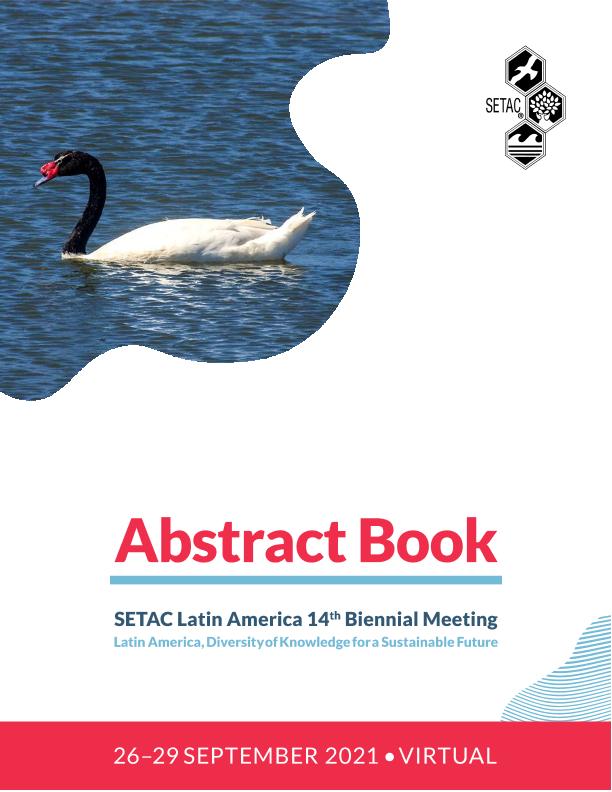Mostrar el registro sencillo del ítem
dc.contributor.author
Truchet, Daniela María

dc.contributor.author
Negro, Carlos Leandro

dc.contributor.author
Buzzi, Natalia Sol

dc.contributor.author
Mora, M. Celeste
dc.contributor.author
Ardusso, Maialen Gisel

dc.contributor.author
Villagran, Diana Mariel

dc.contributor.author
Garcia, Fabian Ezequiel

dc.contributor.author
Marcovecchio, Jorge Eduardo

dc.date.available
2023-02-17T01:48:55Z
dc.date.issued
2021
dc.identifier.citation
A chemo-metric approach to assess heavy metal pollution status in a human impacted coastal system; SETAC Latin America 2021 14th Biennial Meeting; Pensacola; Estados Unidos; 2021; 81-82
dc.identifier.uri
http://hdl.handle.net/11336/188322
dc.description.abstract
Estuaries are among the most threatened coastal environments since they receive several pollutants from riverine discharges, large urban settlements, industries and ports. These human pressures are enhanced in developing countries of South America, such as Argentina, where the biota is at risk due to several pollutants (metals, POPs and microplastics), and therefore, biomonitoring of these areas is highly recommended. However, few studies have achieved this concern and the scientific tools displayed in an integrative way where abiotic and biotic matrices are combined using multiple indices were even less studied. The current study compared metal concentrations (Cd, Cu, Pb, Zn, Mn, Ni, Cr, Fe) in sediments and a resident benthic crab species, Neohelice granulata and the biochemical biomarkers (CAT, GST, H2O2, MT) in this organisms in a salt marsh (SM) and a mudflat (M) in different stations (autumn and spring) of a SW Atlantic estuary (Bahía Blanca estuary, BBE) in Argentina. This area is currently influenced by several industrial and domestic discharges, ports and large scale fisheries. Overall, metals in sediments did not exhibit significant differences between sites and seasons, except for Mn higher in SM during spring. Crabs bioaccumulated more Cu from sediments during autumn than spring for both sites. Except for Cd in M, Mn, Ni and Fe in SM, metals did not exhibit significant differences for sites, but the values tended to increase in autumn. Through geochemical indices, sediments were low to medium polluted with probable adverse biological effects to the biota. Some of the biochemical analyses applied (i.e., IBR) demonstrated high values in the SM during spring with a great contribution of H2O2 and GST. By multivariate analyses (Pearson correlations and PCA), it was possible to observe that the biomarkers induction might be due to natural intrinsic factors such as energetic costs for reproduction and not strictly metallic pollution. But also, it should be considered that during spring, the available organic matter in the estuary is higher and uptakes metals in the SM coming from plants, ultimately incorporated into the body burden of organisms and probably causing biomarkers induction by some correlated metals like Zn, Cu, Mn and Cd.
dc.format
application/pdf
dc.language.iso
eng
dc.publisher
SETAC Latin America
dc.rights
info:eu-repo/semantics/openAccess
dc.rights.uri
https://creativecommons.org/licenses/by/2.5/ar/
dc.subject
ESTUARIES
dc.subject
METALS
dc.subject
BENTHIC SPECIES
dc.subject
BIOMARKERS
dc.subject
GEOCHEMICAL INDICES
dc.subject
SEASONALITY
dc.subject.classification
Ciencias Medioambientales

dc.subject.classification
Ciencias de la Tierra y relacionadas con el Medio Ambiente

dc.subject.classification
CIENCIAS NATURALES Y EXACTAS

dc.title
A chemo-metric approach to assess heavy metal pollution status in a human impacted coastal system
dc.type
info:eu-repo/semantics/publishedVersion
dc.type
info:eu-repo/semantics/conferenceObject
dc.type
info:ar-repo/semantics/documento de conferencia
dc.date.updated
2022-11-04T13:37:09Z
dc.journal.pagination
81-82
dc.journal.pais
Estados Unidos

dc.journal.ciudad
Pensacola
dc.description.fil
Fil: Truchet, Daniela María. Consejo Nacional de Investigaciones Científicas y Técnicas. Centro Científico Tecnológico Conicet - Bahía Blanca. Instituto Argentino de Oceanografía. Universidad Nacional del Sur. Instituto Argentino de Oceanografía; Argentina
dc.description.fil
Fil: Negro, Carlos Leandro. Consejo Nacional de Investigaciones Científicas y Técnicas. Centro Científico Tecnológico Conicet - Santa Fe. Instituto Nacional de Limnología. Universidad Nacional del Litoral. Instituto Nacional de Limnología; Argentina
dc.description.fil
Fil: Buzzi, Natalia Sol. Universidad Nacional del Sur. Departamento de Biología, Bioquímica y Farmacia; Argentina. Consejo Nacional de Investigaciones Científicas y Técnicas. Centro Científico Tecnológico Conicet - Bahía Blanca. Instituto Argentino de Oceanografía. Universidad Nacional del Sur. Instituto Argentino de Oceanografía; Argentina
dc.description.fil
Fil: Mora, M. Celeste. Consejo Nacional de Investigaciones Científicas y Técnicas. Centro Científico Tecnológico Conicet - Santa Fe. Instituto Nacional de Limnología. Universidad Nacional del Litoral. Instituto Nacional de Limnología; Argentina
dc.description.fil
Fil: Ardusso, Maialen Gisel. Consejo Nacional de Investigaciones Científicas y Técnicas. Centro Científico Tecnológico Conicet - Bahía Blanca. Instituto Argentino de Oceanografía. Universidad Nacional del Sur. Instituto Argentino de Oceanografía; Argentina
dc.description.fil
Fil: Villagran, Diana Mariel. Consejo Nacional de Investigaciones Científicas y Técnicas. Centro Científico Tecnológico Conicet - Mar del Plata. Instituto de Investigaciones Marinas y Costeras. Universidad Nacional de Mar del Plata. Facultad de Ciencias Exactas y Naturales. Instituto de Investigaciones Marinas y Costeras; Argentina
dc.description.fil
Fil: Garcia, Fabian Ezequiel. Consejo Nacional de Investigaciones Científicas y Técnicas. Centro Científico Tecnológico Conicet - Bahía Blanca. Instituto Argentino de Oceanografía. Universidad Nacional del Sur. Instituto Argentino de Oceanografía; Argentina
dc.description.fil
Fil: Marcovecchio, Jorge Eduardo. Consejo Nacional de Investigaciones Científicas y Técnicas. Centro Científico Tecnológico Conicet - Bahía Blanca. Instituto Argentino de Oceanografía. Universidad Nacional del Sur. Instituto Argentino de Oceanografía; Argentina
dc.relation.alternativeid
info:eu-repo/semantics/altIdentifier/url/https://sla2021.setac.org/
dc.conicet.rol
Autor

dc.conicet.rol
Autor

dc.conicet.rol
Autor

dc.conicet.rol
Autor

dc.conicet.rol
Autor

dc.conicet.rol
Autor

dc.conicet.rol
Autor

dc.conicet.rol
Autor

dc.coverage
Internacional
dc.type.subtype
Congreso
dc.description.nombreEvento
SETAC Latin America 2021 14th Biennial Meeting
dc.date.evento
2021-09-26
dc.description.ciudadEvento
Pensacola
dc.description.paisEvento
Estados Unidos

dc.type.publicacion
Book
dc.description.institucionOrganizadora
Society of Environmental Toxicology and Chemistry
dc.source.libro
SETAC Latin America 2021 14th Biennial Meeting
dc.date.eventoHasta
2021-09-29
dc.type
Congreso
Archivos asociados
